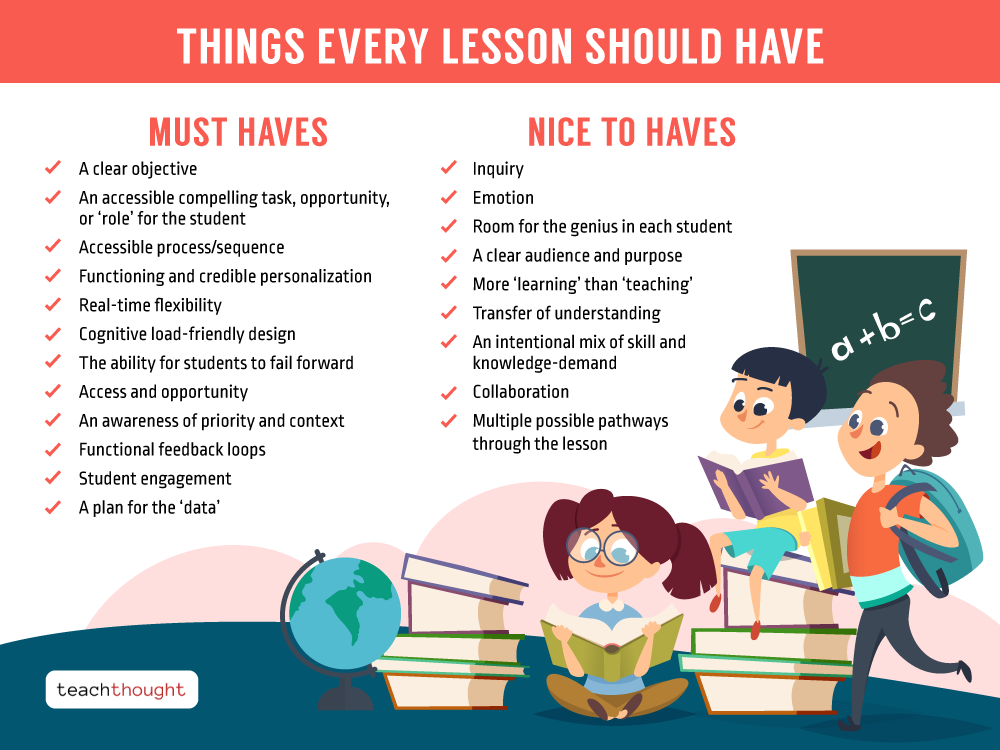
What Should Be In Every Lesson Plan?
by Terry Heick
What should every lesson plan have?
It’s a challenge to say what every single lesson imaginable should always have every single time no matter what. There are always exceptions.
But what elements should be in nearly every lesson nearly every time? I could’ve kept the list shorter and gotten closer to ‘every single lesson every single time,’ but didn’t see the point in that when the goal here is to help you think about what you plan and how you plan it.
A clear enough premise, so let’s get to it.
1. A clear objective
Note, this doesn’t have to be ‘standards-based’ or even academic. But the teacher should be clear what they’re trying to ‘change’ in students.
(And that learning objective should be within the ‘Zone of Proximal Development’ for each student more on that below).
2. An accessible compelling task, opportunity, or ‘role’ for the student
See also The Benefits And Necessity Of Interdisciplinary Education
Every lesson should have a clear and compelling–and accessible–role for each student that they can ‘perform’ during every moment of the lesson. Something you expect for them to do during the lesson and be able to do after/as a result.
3. Accessible procedural knowledge
That is, it should be clear exactly what students have to ‘do’ in terms of process and procedure–and they should be able to do it.
4. Functioning and credible personalization
Whether student voice and choice, differentiation of process, product, or pathway, the specification of a specific learning standard for a specific student at a specific time, every lesson should (at minimum) have some kind of flexibility built in that honors the different ‘places’ every student is, has been, and will be (in terms of knowledge, skills, etc.)
5. Real-time flexibility
To personalize, the ability to be flexible in real-time helps.
What if the electricity goes out during the lesson? Or if students who have previously demonstrated mastery of a topic simply don’t ‘get it’ the way you thought they might. What if one group finishes an activity much faster than the others? Or four students clearly know the content already and aren’t really learning much of anything at all?
As much as possible, try to create lessons and activities that can easily be adjusted in real-time.
6. Cognitive load-friendly design
If a student struggles to read (decode), comprehension-based tasks will be difficult. If a student is both learning new material and being asked to interpret new tasks based on new material–while making sense of the procedural steps, etc.–the short-term memory can become a bottleneck to even complete tasks, much less learn anything new.
Much less, for that student to be at their best. ZPD plays a core function in this kind of analysis (see above). You can read more about the Cognitive Load Theory.
7. The ability for students to fail forward
Great lesson design limits how often students ‘fail badly’ (see ZPD, for example).
Obviously, students ‘fail.’ But the nature and tone of that failure is the difference between a ‘rigorous lesson’ and a ‘human lesson meant to grow children.’
8. Access and opportunity
Clear access and opportunity for every student–even if that access and opportunity is different for every student.
This is similar to numbers 2 and 4, but the real focus here is the ‘big picture’ of the lesson and whether or not it’s truly something useful for every student. Something useful and human. Written in a language they understand in pursuit of goals credible–or at least accessible–to them.
See Equity and the Power of Unspoken Words.
9. An awareness of priority and context
This is more about content, learning targets/objectives, and so on. Think: When have they seen this before, and when will they see it again? How important is it?
What did they learn prior to this? How will this fit into what they already know? Into the curriculum map? Into the assessments I have planned? Into their grade? Into their lives? (See 40/40/40 rule, for example.) It’s all about context.
10. Functional feedback loops
You can read more about feedback loops here. For now, know that they are the foundation for how the brain learns.
11. Student engagement
This should be ‘higher’ but the list isn’t ranked by importance and it’s obvious: if students aren’t engaged, nothing else matters.
How to accomplish this is, of course, complex. But ideally, the engagement is accomplished through a range of means: lesson design, student roles, learning models, student curiosity, etc. If the primary cause of engagement is your charisma, classroom management skills, or strong teacher-student relationships (something I sometimes depend on too much as a teacher), there’s room for improvement.
12. A plan for the ‘data’
Not every lesson will have formal ‘data collection’ but any observable human behavior offers some kind of empirical ‘data’ and most (all?) lessons should have a plan for using that data before the lesson is taught.
Things It’s Nice For Every Lesson To Have
Inquiry
I really wanted to put this on the list but can think of too many ‘good’ lessons possible without it.
Emotion
The same goes for emotion. It’s wonderful but not necessary.
Room for the genius in each student
A clear audience and purpose
Again–not all lessons will have an ‘audience’ and many wonderful assignments won’t be accomplished some outward-facing ‘purpose.’
More ‘learning’ than ‘teaching’
An intentional mix of skill and knowledge-demand
Transfer of understanding
Collaboration
Multiple possible pathways through the lesson
A clear movement from ‘lower order thinking’ to ‘higher order thinking’
An awareness of how the human brain learns
Things Every Lesson You Teach Should Have
